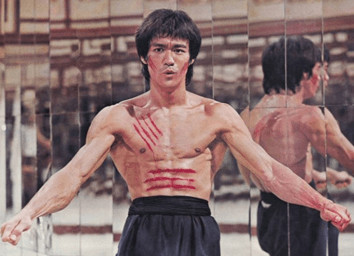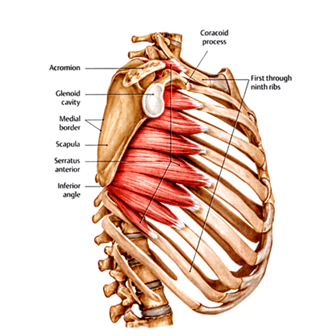What is your 'Fight Muscle,' anyway? Is it your fist? Your big guns? Glutes or pecs? Nope. Not even close…and yes, it really effing matters!
Combat athletes rely on Combat Arts Strength and Conditioning to Achieve Peak Performance, more specifically to power their fight muscle for brutal punches, lethal elbow strikes, devasting uppercuts, strong blocks, explosive takedowns…it powers their entire game. The fight muscle, better known as the serratus anterior muscle, encompasses the top eight ribs and is easy to spot on a ripped combat athlete's body since, as the name implies, it gives a 'serrated knife edge look.'
Remember that iconic Bruce Lee photo from "Enter the Dragon" where he pops his side 'wings' and fans them out? Those jagged-edged muscles on his ribs are the serratus anterior muscles and are a major reason he punched like a sledgehammer …say hello to your fight muscle, the serratus anterior.

Source: Warner Home Video
Bottom Line—A WEAK FIGHT MUSCLE EQUALS A WEAK FIGHTER!
Serratus anterior is also known as the "boxer's muscle" because it is responsible for the explosive speed, range of motion, and extreme mobility required by combat athletes to achieve effective power throughout their reach extension!
The serratus anterior muscles do a lot more than power your strikes as if that wasn't enough! It provides inner structural integrity and strength to your upper body.
Many combat athletes focus primarily on the front of the body—what they can see. Over time this creates an integral weakness in overall muscle structure. It builds muscle strength imbalances. The front muscles become stronger than the back muscles, which then pull everything out of alignment.
Did you ever play tug o' war with a rope as a kid in a strength contest? Muscle misalignment is similar to that - when the muscles on the front of your body are stronger than those in the back, and injury may occur.
"Combat Arts Strength Training is the Foundation of a Fighters Success"; however, success can be short changed by weak muscles. And in this case, weak serratus anterior muscles not only decrease your punching power but output as well.
This unsung hero supports your rotator cuff, strengthens, reinforces your neck, helps protect against tendonitis, supports breathing by opening the rib cage, and helps reduce the risk of a severe injury.
Combat Arts Strength Training: Foundation of a Fighters Success
Zach Says, "Not So Fast"!
Zach Fanjoy is a Brown Belt in Brazilian Jiu-Jitsu and a Strength and Conditioning Coach specializing in Combat Arts Injury Prevention and Rehabilitation. He became interested in injury rehabilitation and teaching combat athletes to support their bodies through the correct application of exercise when at the age of 16 his lung collapsed while on the mat during a wrestling takedown.
A few nasty surgeries later, including spreading the ribs to remove a mass on the lung, he finally recovered. Through this experience, Zach became fascinated with the science and application of strength training for rehabilitation and recovery, which is good for the rest of us!

Zach believes under-stimulating the serratus anterior or your fight muscle is a serious issue that will break down a combat athlete's body over time. Ignoring and overlooking the serratus anterior is easy to do. Plus, the results from training the serratus anterior muscles are not immediately apparent—it's not like beefing up your biceps where you quickly see a difference.
Even the strongest, toughest combat athletes must start light, initially using minimal weights, and feel content with small though significant increases in explosive power, strength, and muscle size as they get their serratus fully activated.
Zach Says, "Let's DO This"!
Zach recommends the following exercises to strengthen and activate your serratus. Keep in mind all you high-testosterone maniacs out there when Zach says to Only Use a 3-Pound Weight—he means it! Why? It turns out this muscle is a picky one; if you do nothing—it goes dormant and messes you up—if you go too hard and heavy too fast—it injures easily and yup, messes you up!
Once activated, though, your serratus anterior gives as good as it gets. It just might become your favorite muscle as it drives your collection of tournament belts. Once a 3-pound weight feels easy, then move on to a 5-pound weight.
Zach's Top Exercise Picks for ACTIVATING YOUR FIGHT MUSCLE
Your fight muscle is NOT easy to strengthen and train. According to Zach, the tricky part is training in a manner that carefully 'activates’ the muscle, like jumpstarting a battery or flipping the 'on' switch to high.
To activate the serratus anterior muscles train carefully, slowly, even religiously. The training process is subtle, and it can be tedious. But as your serratus muscles gradually build-up, your punches will become more intense, more volcanic, and devastatingly brutal. So, what are you waiting for? Power Up Your Fight Muscle Now!
